Triamcinolone dosages: 40 mg, 15 mg, 10 mg, 4 mg
Triamcinolone packs: 60 pills, 90 pills, 120 pills, 180 pills, 270 pills
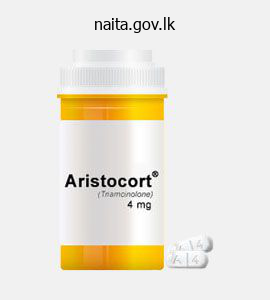
Triamcinolone 4mg visa
Transcatheter arterial chemoembolization with or without radiofrequency ablation in the administration of sufferers with superior hepatic malignancy. Complication, local recurrence, and survival rates after radiofrequency ablation for hepatic malignancies. Patients may 218 present with signs as early as 30 years of age, and the disease is often fatal inside 10 years. Amyloidogenic mutations in the transthyretin gene, the most common being T60A in transthyretin protein, induce hepatic synthesis of insoluble amyloid, which accumulates in varied organs, notably the guts, peripheral nerves, gastrointestinal tract, and kidneys. Over time, amyloid may be recycled and tissue damage corrected, but the threat for cardiac arrhythmia stays, particularly in the perioperative period. In secondary hemochromatosis (right), systemic iron overload and organ damage can result from various acquired processes, for example, hypertransfusion for severe and lifelong anemia. Exposure of hemophiliac sufferers to blood product concentrates can lead to viral hepatitis, cirrhosis, and liver failure. The cumulative risk for hepatic decompensation in hemophiliacs with hepatitis C is 1. Treatment makes use of anticoagulant medicine plus infusion of blood merchandise containing protein C (plasma or protein C concentrate). Homozygous protein C deficiency (left) presents peripartum with life-threatening purpura fulminans. A second case concerned an 8-year-old youngster who was a compound heterozygote for protein C deficiency and dysfunction69 and who developed renal failure secondary to bilateral renal vein thrombosis, and intracranial hemorrhage and gastrointestinal bleeding complicating persistent anticoagulant therapy. After a mixed renal/liver transplant the patient was weaned off protein C focus by 2 weeks after transplant, when plasma protein C activity was maintained at larger than 70%. Follow-up 1 year after transplantation demonstrated normal protein C exercise and graft perform. Normal protein C exercise and antigen and wonderful graft operate continued 8 years after transplantation. Worsening hepatic harm may additional lower ferrochelatase exercise, making a vicious cycle that promotes progressive hepatic failure. Phototoxic burns on the stomach and viscera ensuing from intense gentle exposure throughout surgery are brought on by publicity of protoporphyrin to ultraviolet mild and can lead to biliary fistula, intestinal perforation, and even death. The impact that hematin has on hepatic disease continues to be unclear, but a lower in postadministration plasma protoporphyrin levels has been correlated with increased excretion in feces and urine. Reduction in the size of hemangiomas has been noticed with antiangiogenic agents interferon alpha2115,123 and bevacizumab,124 corticosteroids, and cyclophosphamide,125 however no randomized, controlled trials have been performed. Intraoperative blood loss is excessive, imply 12 L, and the large size of the hemangioma and the native liver current further technical challenges. Arterial ligation earlier than mobilization of the liver can be helpful in lowering the hemangioma measurement. Giant hepatic hemangiomas can cause compressive signs and consumptive coagulopathy due to platelet sequestration, clotting, and fibrinolysis within the hemangioma. Underlying Defect Almost utterly corrected Probably not corrected Correction of factor deficiency to variable degree Completely corrected Not corrected Partial correction (liver however not different tissues) Completely corrected if hemangiomas primarily in liver Transplantation of faulty liver Clinical Result Stabilization or enchancment in organ operate if additional amyloid deposition prevented Immediate correction of hepatic failure Hepatic failure corrected Prevention of spontaneous bleeding Thrombophilia cured, no want for anticoagulation Hepatic failure corrected Resolution of hepatic failure Resolution of compressive hepatic signs, coagulopathy Induction of thrombophilia or hemophilia Potential Problems Cardiac and other organ perform may not enhance (deposition of wild-type transthyretin) Reaccumulation of tissue iron May nonetheless require issue for surgical procedures Recurrent viral hepatitis Risk for vascular complications Likely would require ongoing antithrombotic remedy Possible phototoxic damage (neuropathy) throughout surgical procedure Recurrent disease Perioperative bleeding and coagulopathy Rare incidence hepatic vessel thrombosis is low. Acquired protein S deficiency138 and mixed protein C deficiency and dysfibrinogenemia139 resulting in thrombosis have also been reported. This remedy is acceptable for hereditary hemochromatosis with advanced liver illness, but it might not alleviate iron-related injury in other organs or the underlying genetic defect. Clinical enchancment and amyloid regression after liver transplantation in hereditary transthyretin amyloidosis. Changes in renal perform in patients with familial amyloid polyneuropathy treated with orthotopic liver transplantation. Peripheral nerves regenerated in familial amyloid polyneuropathy after liver transplantation. Deposition and passage of transthyretin by way of the blood-nerve barrier in recipients of familial amyloid polyneuropathy livers. Systemic however asymptomatic transthyretin amyloidosis eight years after domino liver transplantation. Iatrogenic amyloid neuropathy in a Japanese affected person after sequential liver transplantation.
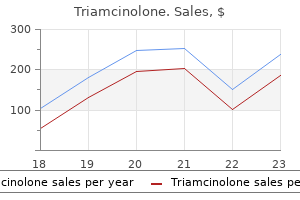
Discount triamcinolone
Magnesium sulphate injected subcutaneously suppresses autotomy in peripherally deafferented rats. Naguib An analgesic is any member of the group of medicine which might be used to lower pain sensation without loss of consciousness. Peripheral analgesics act on the sensory input degree by blocking transmission of the impulse to the brain. Their common function was believed to be their website of motion throughout the damaged tissues, and hence they were termed peripheral analgesics. Experimental and scientific studies help the potential for central website of action of many of these brokers. In addition, peripheral administration of medication can doubtlessly optimize drug concentrations at the website of the origin of pain while resulting in lower systemic levels and fewer adverse systemic effects and fewer drug interactions. Peripheral nerve endings also express quite a lot of inhibitory receptors similar to opioid, a-adrenergic, cholinergic; adenosine and cannabinoid receptors, and agonists for these receptors also represent viable targets for drug growth. Tissue injury results in peripheral launch of endogenous mediators that can directly activate nociceptive afferent fibers, sensitize nociceptors, and/or cause elevated native extravasation and vasodilatation. Nociceptive afferents have their neurons within the dorsal root ganglion and contact second-order neurons within the dorsal horn (for extra particulars, see Chapter 6, Pain Physiology). However, increased cardiovascular risk has been associated with using this class of medication. Naproxen has no impact on vascular outcomes however does increase higher gastrointestinal complications. Prostaglandins and prostacyclins are important for maintenance of intrarenal blood flow and tubular transport. The impact of prostaglandin inhibition might end in premature closure of the ductus arteriosus. Combination use of corticosteroids and aspirin can enhance renal clearance of salicylate and signifi antly lower plasma salicylate concentrations. Acetaminophen is antipyretic and analgesic however has little, if any, antiinflammatory action. Acetaminophen is the main explanation for acute liver failure in the United States, and nearly half of acetaminophenassociated instances are because of unintentional overdose. Debate exists about its primary site of motion, which can be inhibition of prostaglandin synthesis. However, acute overdosage could cause extreme hepatic damage, and the variety of unintended or deliberate poisonings with acetaminophen continues to grow. The pharmacology of acetaminophen overdose, including its time course and treatment is fascinating and necessary to know. Activated charcoal can be utilized to lower absorption of acetaminophen in those that present, soon after ingestion of, an overdose. Acetylsalicylic acid (Aspirin) Aspirin is the oldest and most generally used medicinal compound on the planet. Aspirin is present in lots of of over-the-counter medicines worldwide, and remains at the forefront of medicine, with newly found applications for the prevention and remedy of several life-threatening diseases. Aspirin effectively treats headaches, again and muscle pain, and other common aches and pains. Appropriate hydration and activated charcoal ought to be thought-about inside 1 hour after ingestion. Its antiinflammatory motion ends in decreased production of assorted inflammatory mediators that play a significant function in amplifying and upkeep of ache perception. Another proposed mechanism is by inhibition of phospholipase A2 in addition to adjustments in cell operate induced by glucocorticoid receptor activation. Corticosteroids are a subgroup of compounds known as adrenocorticoids that are naturally secreted from the adrenal gland. Many synthetic brokers which are more potent, have longer durations of motion, have higher antiinflammatory exercise, and generate fewer unwanted mineralocorticoid unwanted effects than hydrocortisone have been developed. Mineralocorticoids are adrenal cortical steroid hormones that have a higher impact on water and electrolyte stability.
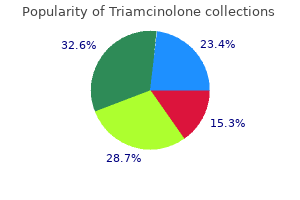
Purchase genuine triamcinolone
The hilar mass should be three cm or much less in diameter and be 5 Organ allOcatiOn: the U. Exception scores for other circumstances, corresponding to polycystic liver illness, may be granted on a case-by-case foundation after review and approval by a regional evaluation board. In a system that directs organs to the sickest candidates and basically eliminates waiting time as a variable, one would count on each a reduction in ready list mortality and in time to transplant. Achieving extra equitable allocation, as really helpful by the Final Rule, would require changes in liver distribution or broader sharing of available organs. Current liver distribution boundaries in the United States are somewhat arbitrary and largely based on these established for kidney transplantation. One proposal is to broaden distribution units into zones or concentric distance circles, such as the five zones of distribution utilized in lung allocation (0 to 500, 500 to 1000, a thousand to 1500, 1500 to 2500, >2500). Several historic and political boundaries might want to be overcome before implementation of this sort of liver distribution. Expansion of the "regional share 15" coverage to a "nationwide share 15" is underneath active consideration. Several investigators have shown that the addition of serum sodium degree to the score offers a better estimate of ready listing mortality. History of deceased organ donation, transplantation, and organ procurement organizations. Report of the Ad Hoc Committee of the Harvard Medical School to Examine the Definition of Brain Death. Protection of human subjects; Belmont Report: discover of report for public comment. Survival after elective transjugular intrahepatic portosystemic shunt creation: prediction with mannequin for end-stage liver disease rating. Pearls and Pitfalls · the Uniform Anatomical Gift Act was passed in 1968, establishing a authorized basis for organ transplantation. Development of a pediatric endstage liver illness score to predict poor consequence in children awaiting liver transplantation. United Network for Organ Sharing Organ Procurement and Transplantation Network Liver and Transplantation Committee. Survival after liver transplantation for hepatocellular carcinoma in the mannequin for end-stage liver illness and pre-model for end-stage liver disease eras and the independent impact of hepatitis C virus. A revised mannequin for endstage liver illness optimizes prediction of mortality amongst patients awaiting liver transplantation. Persijn · Rafael Matesanz · Gloria de la Rosa · Paolo Muiesan · Andrew Burroughs · Gabriela A. Table 6-1 lists the liver transplant activity and organ donation charges in numerous European nations and regions. Table 6-2 lists the main indications for end-stage liver illness and liver transplantation. As in the United States, liver cirrhosis ensuing from chronic hepatitis C and alcoholic cirrhosis are the principle and rising indications for liver transplantation. This chapter gives an overview and outline of some different European organ allocation systems and organizations. The variations offered mirror differences in legislation, organ donation rates, indications for liver transplantation, and traditions within the follow of drugs in different international locations and areas of Europe. Most organizations have similar guidelines with an urgent priority group that features acute hepatic failure and early retransplantation following vascular thrombosis, as well as main nonfunction. Although no universally accepted liver allocation guidelines exist, two methods are primarily followed. An organ allocation system is a matter of consensus amongst transplant teams, organizational structures, health authorities, and customer and patient organizations. The second class is nonmedical standards, which embrace geographical distance and resources consumed. This info ought to include criteria for registration and allocation, figures and flows of registered sufferers, and average waiting occasions for different teams of patients. The system should guarantee, as far as potential, that no group of patients waits longer than another group. There is, however, an increasing collaboration with some former eastern European countries with acknowledged allocation methods and organizations. The aim is to use donor organs fully and, extra importantly, to develop the field of organ transplantation in these international locations to the extent of the relaxation of Europe.
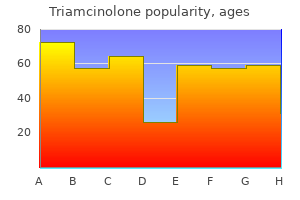
Purchase 4 mg triamcinolone with visa
Number of donors, transplants, and patients on the lively transplant listing as of March 31, 2012. More specifically, the Liver Advisory Group and its subgroup Liver Selection and Allocation Working Party discuss issues concerning liver graft allocation, making certain fairness of access to transplantation. They also give approval for organ donations from dwelling people through an impartial assessment course of. These groups are based mostly in liver and cardiothoracic transplant centers, respectively. The system is led by marketing consultant surgeons and is designed to enhance efficiency and cut back journey time and prices. Donor zones are allotted to each middle based on the variety of new registrations on the waiting listing of prospective candidates. This is to match the number of potential donors to the needs of the particular heart, mirrored by the scale of their ready record. If the organ is declined, it will be absolutely provided to the second in line via the liver allocation sequence. The heart with the least number of transplants during this period will appear on the high of the sequence, right down to the middle with the most variety of transplants. There is a big variety of elements influencing the decision of the transplant skilled, together with quality and size of the donated liver, blood group, health condition of the potential recipient, and logistics of pressure on intensive care unit beds and on employees. The determination whether a liver must be transplanted into an individual should take account of each recipient and donor factors. In all instances centers must respond by telephone within 30 minutes to advise whether they want to accept or decline the supply. The Duty Office will follow up those facilities who fail to reply within the required 30 minutes to ascertain the cause why the offer was declined. Teams retrieving livers from such donors ought to provide an appropriate reason in the occasion that they decide to not break up, usually associated to liver operate, hemodynamic instability, or quality of the graft. Left lateral segments from O blood group donors have to be offered for O and B blood group pediatric patients nationally before consideration is given to different blood group pediatric patients. Ethical concerns continue to be mentioned, mainly concerning the donor morbidity and mortality related to the process. Super-Urgent Patients are prioritized as super-urgent if they require a new liver as quickly as possible due to fast failure of the native organ or of the liver graft. Categories 5 and 6 include seronegative hepatitis, hepatitis A or hepatitis B, or an idiosyncratic drug response. In abstract, for grownup (age sixteen years or weight 35 kg) and pediatric (age < 16 years or weight < 35 kg) liver donors, the sequence for allocating liver grafts is analogous and is the next: 1. As with other organ change organizations, its initial function was to allocate kidneys. Scandiatransplant is a collaboration of all organ transplant facilities in the Nordic countries-Sweden, Norway, Finland, and Denmark. There are currently 5 liver transplant facilities inside Scandiatransplant (two in Sweden and one in each of the other Nordic countries). By the end of 2011, 4550 liver transplantation procedures had been performed within the Nordic countries, with an total 1-year graft and patient survival of 86% and 90%, respectively. The main indications for liver transplantation in sufferers with chronic liver illness within the Nordic nations are primary sclerosing cholangitis (21%), hepatocellular carcinoma (16%), alcoholic cirrhosis (approximately 13%), acute fulminant liver failure (7%), and continual hepatitis C (7%). In 2011 the median donor age for first-time liver transplantation recipients was fifty three. Centeroriented allocation is used, and each transplant middle has its personal ready listing and the best to transplant livers procured from a defined geographical space. The organs are, nevertheless, procured by the local transplant team and then sent to the transplanting center. The excessive urgent standing is based solely on the prognosis and clinical standing and the evaluation made by the accountable hepatologist along with the transplant surgeon and intensive care physicians. The high urgent name standing of the sufferers who qualify remains in effect for a most of 3 days.
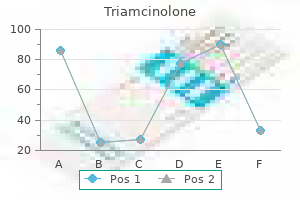
Purchase cheap triamcinolone on-line
Oxidant injury to hepatic mitochondrial lipids in rats with dietary copper overload. Pattern of diagnostic analysis for the causes of pediatric acute liver failure: an opportunity for quality enchancment. Initial therapy in complete of 55 neurologically affected patients and follow-up with zinc therapy. A modified automated fluorometric method for tyrosine willpower in blood spotted on paper: a mass screening procedure for tyrosinemia. Fumarylacetoacetase measurement as a mass-screening process for hereditary tyrosinemia kind I. Neurological disaster in hereditary tyrosinaemia and complete reversal after liver transplantation. Succinylacetone results on renal tubular phosphate metabolism: a mannequin for experimental renal Fanconi syndrome. Homotransplantation of the liver in a affected person with hepatoma in hereditary tyrosinemia. Liver transplantation for hereditary tyrosinemia in the presence of hepatocellular carcinoma. The results of early therapy of hereditary tyrosinemia kind I in infancy by orthotopic liver transplantation. Liver transplantation in tyrosinaemia type 1: the dilemma of timing the operation. Resolution of the medical options of tyrosinemia following orthotopic liver transplantation for hepatoma. Rapid enchancment within the renal tubular dysfunction associated with tyrosinemia following hepatic substitute. Contribution of extrahepatic tissues to biochemical abnormalities in hereditary tyrosinemia kind I: study of three patients after liver transplantation. Improvement in true glomerular filtration fee after cyclosporine fractionation in pediatric liver transplant recipients. Treatment of episodic hyperammonemia in children with inborn errors of urea synthesis. Survival after therapy with phenylacetate and benzoate for urea cycle problems. Early orthotopic liver transplantation in urea cycle defects: comply with up of a developmental outcome study. Focal glycogenosis of the liver in disorders of ureagenesis: Its prevalence and diagnostic significance. Fatal clinical course of ornithine transcarbamylase deficiency in adult heterozygous female affected person. An integrated strategy to the analysis and potential administration of partial ornithine transcarbamylase deficiency. Application of reduced-size liver transplants as split grafts, auxiliary orthotopic grafts, and residing associated segmental transplants. Liver transplantation for classical maple syrup urine disease: long-term follow-up in 37 patients and comparative United Network for Organ Sharing expertise. Liver transplantation in youngsters with glycogen storage illness: controversies and evaluation of the risk/benefit of this process. Long-term results of living donor liver transplantation for glycogen storage issues in kids. Familial hypercholesterolemia: a genetic defect within the low-density lipoprotein receptor. The role of orthotopic liver transplantation in the remedy of ornithine transcarbamylase deficiency. Treatment of ornithine transcarbamylase deficiency in ladies by auxiliary liver transplantation: Conceptual changes in a living-donor applications. Persistent acitrullinemia after liver transplantation for carbamylphosphate synthetase deficiency. Current function of liver transplantation for methylmalonic acidemia: A review of the literature. Combined liver-kidney transplant for the administration of methylmalonic aciduria: a case report and review of the literature.
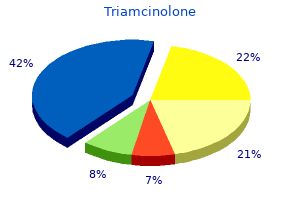
Buy triamcinolone line
Chloroprocaine Addition of a chlorine atom to the benzene ring of procaine to kind chloroprocaine will increase by three. Resulting pharmacologically inactive metabolites of chloroprocaine are 2-chloro-aminobenzoic acid and 2-diethylaminoethanol. As such, benzocaine is ideally suited to topical anesthesia of mucous membranes prior to tracheal intubation, endoscopy, transesophageal echocardiography, and bronchoscopy. The price of hydrolysis varies, with chloroprocaine being most speedy, procaine being intermediate, and tetracaine being the slowest. The ensuing metabolites are pharmacologically inactive, although paraaminoben- Chapter 10 � Local Anesthetics 291 anesthesia is fast and lasts 30 to 60 minutes. Systemic absorption of topical benzocaine is enhanced by defects in the pores and skin and mucosa as properly as from the gastrointestinal tract ought to any of the native anesthetic be swallowed. The product Cetacaine is marketed as a mixture of 14% benzocaine, 2% tetracaine, and 2% butamben in a topical applicator that acts as an atomizer. Methemoglobinemia is a uncommon but potentially life-threatening complication following topical application of benzocaine, especially when the dose exceeds 200 to 300 mg (see the part "Methemoglobinemia"). Cocaine Cocaine is metabolized by plasma and liver cholinesterases to water-soluble metabolites which would possibly be excreted in urine. Plasma cholinesterase activity is decreased in parturients, neonates, the aged, and patients with severe underlying hepatic illness. Assays for the metabolites of cocaine in urine are useful markers of cocaine use or absorption (see the part "Cocaine Toxicity"). Nevertheless, placement of chloroprocaine in the epidural space might decrease the efficacy of subsequent epidural bupivacaine-induced analgesia during labor. For these causes, adjustment of the pH of the chloroprocaine answer with the addition of 1 mL of eight. The pKa of native anesthetics used clinically is near 8, so that only a small fraction (about 3%) o f the native anesthetic exists in the lipid-soluble type. Adding sodium bicarbonate will speed the onset of peripheral nerve block and epidural block by three to 5 minutes. Use of Vasoconstrictors the duration of action of an area anesthetic is proportional to the time the drug is in touch with nerve fibers. For this purpose, epinephrine (1:200,000 or 5 mg/mL) could also be added to native anesthetic options to produce vasoconstriction, which limits systemic absorption and maintains the drug concentration within the neighborhood of the nerve fibers to be anesthetized. Indeed, addition of epinephrine to a lidocaine or mepivacaine solution prolongs the length of conduction blockade and decreases systemic absorption of native anesthetics by 20% to 30%. For example, the impression of epinephrine in prolonging the length of conduction blockade and reducing systemic absorption of bupivacaine and etidocaine is less than that observed with lidocaine, presumably as a end result of the higher lipid solubility of bupivacaine and etidocaine causes them to bind avidly to tissues. The period of sensory anesthesia in Adjuvant Mixed with Local Anesthetics Dexmedetomidine has been used as an adjuvant in native anesthetic admixtures and a central effect is postulated for prolongation of the local anesthetic have an result on. Th a-adrenergic results of epinephrine may be related to some degree of analgesia that would contribute to the effects of the conduction blockade. The addition of epinephrine to native anesthetic solutions has little, if any, effect on the onset price of local anesthesia. Decreased systemic absorption of local anesthetic because of vasoconstriction produced by epinephrine increases the probability that the speed of metabolism will match that of absorption, thus lowering the potential for systemic toxicity. Whenever local anesthetic solutions containing epinephrine are administered within the presence of inhaled anesthetics, the chance of enhanced cardiac irritability should be thought of. It is estimated that less than 1% of all opposed reactions to local anesthetics are because of an allergic mechanism. An allergic response after the use of a local anesthetic may be due to methylparaben or similar substances used as preservatives in commercial preparations of ester and amide local anesthetics. Cross-Sensitivity Cross-sensitivity between native anesthetics reflects the frequent metabolite paraaminobenzoic acid. Likewise, an ester native anesthetic could be administered to a patient with a known allergy to an amide native anesthetic. Adverse Effects of Local Anesthetics the principal side effects associated to the use of native anesthetics are allergic reactions and systemic toxicity as a result of excessive plasma and tissue concentrations of the native anesthetic. The incidence of rash, urticaria, and laryngeal edema, with or without hypotension and bronchospasm, is very suggestive of a neighborhood anesthetic�induced allergic response. Conversely, hypotension related to syncope or tachycardia when an epinephrine-containing native anesthetic solution is run suggests an accidental intravascular injection of drug.
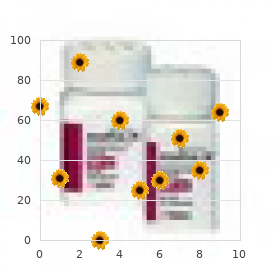
Buy triamcinolone 4 mg lowest price
Adhesion is fashioned as early as 5 7 days after surgical procedure, although they could not manifest for a while. Acute ache happens with intestinal obstruction, when vomiting, inability to pass flatus and stomach distension occur. Chronic obstruction causes intermittent symptoms, with tubercular peritonitis causing cysts or chronic symptoms. There is much less danger of adhesions if organs and tissues are handled gently and trauma to the visceral peritoneum averted. Sutures over the visceral peritoneum (peritonization) and parietal peritoneum ought to be avoided-this is expected to reduce adhesions. Earlier, when postoperative adhesions have been anticipated, omental or peritoneal graft was placed over the suture line. Placentrex appears to help in dissolving adhesions if given early within the administration. Since trauma and bleeding kind part of any surgery, formation of postoperative adhesion of no matter degree and severity seems to be inevitable. Lately, some steps have been launched to cut back postoperative adhesions in the type of insertion of adhesion-reducing agents. Locally, they get absorb-Assed too rapidly into systemic circulation to be efficient. Physical obstacles have been next launched to keep the 2 traumatic surfaces separate or to cover the uncooked sutured space. Adept (4% icodextrin) solution has a sufficiently long peritoneal residence and offers hydroflotation through the essential period of adhesion formation (57 days). It has been shown to reduce the incidence, extent and severity of postoperative adhesions. Interceed can nonetheless kind adhesions if not correctly applied and in the presence of incomplete haemostasis and infection. Seprafilm (hyaluronic acid with carboxymethylcellulose) is a movie positioned over the suture line. It remains in the course of the interval of re-epithelization and will get spontaneously absorbed. The sheet is agency and non-compliant and tough to insert throughout laparoscopic surgical procedure. It is principally used underneath the anterior abdominal wall to prevent intestinal adhesions, in order that repeat surgical procedure is secure. Hydroflotation n Conclusion It is tough to realize the incidence, extent and severity of postoperative adhesions following belly surgery. In a high-risk case or as a routine, some type of anti-adhesion gadget needs to be positioned on the end of surgical procedure. Research is on for a safe, effective barrier to cut back this complication and make repeat surgery protected. Postoperative adhesions enhance morbidity and lead to early or late complications, affecting the standard of life in a girl. Interceed (oxidized regenerated cellulose) is an absorbable barrier launched in the Nineteen Nineties. Advanced surgical technologies have additionally contributed to lowered surgical morbidities and operation-related problems. It is due to this fact important to pay due attention to preoperative and postoperative administration of a woman present process surgery. The preoperative investigations embody the following: n Purpose of Preoperative Care It is the cornerstone for profitable surgical end result. Particularly in girls giving a history of jaundice and in all ladies present process most cancers surgery. Identify the danger components, any irregular situation and rectify this earlier than enterprise surgery. Correct Diagnosis Detailed history and clinical examination can result in correct prognosis in most cases. History includes the presenting signs, drugs taken, any allergy and former blood transfusion and surgery.
References
- Rocchiccioli F, Wanders RJ, Augburg P, et al. Deficiency of long-chain 3-hydroxyacyl-CoA dehydrogenase: a cause of lethal myopathy and cardiomyopathy in early childhood. Pediatr Res. 1990;28:657-662.
- Zuidema J, Hilbers-Modderman ES, Merkus FW. Clinical pharmacokinetics of dapsone. Clin Pharmacokinet 1986;11:299-315.
- Chalfoun, C. T., McConnell, M. P., Wirth, G. A., et al. Free tensor fasciae latae flap for abdominal wall reconstruction: overview and new innovation. J Reconstr Microsurg. 2012; 28(3):211-219.
- Klausner JD, Zukerman C, Limaye AP, et al. Outbreak of Stenotrophomonas maltophilia bacteremia among patients undergoing bone marrow transplantation: association with faulty replacement of handwashing soap. Infect Control Hosp Epidemiol. 1999;20(11):756-758.
- Schneider E, Cowan KH, Multiple drug resistance in cancer therapy. Med J Aust 1994;160(6):371-373.
- Skinner MA, Safford SD, Reeves JG, et al: Renal aplasia in humans is associated with RET mutations, Am J Hum Genet 82(2):344-351, 2008.